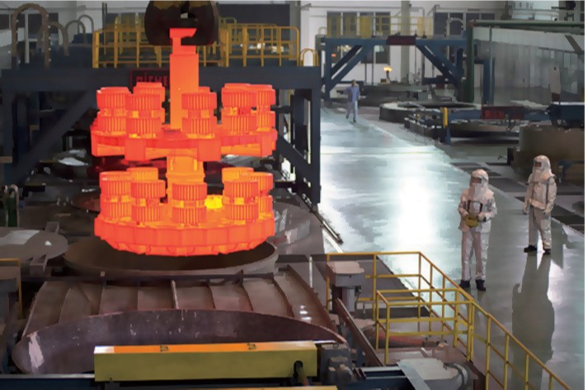Quenching
What is quenching?
Quenching of steel refers to a heat treatment process where the steel is heated to the critical temperature above Ac3 (for hypo-eutectoid steel) or Ac1 (for hyper-eutectoid steel). It is held at that temperature for a certain period, causing a complete or partial transformation into austenite. Subsequently, it undergoes rapid cooling at a rate greater than the critical cooling rate, quickly reaching below Ms (or in the vicinity of Ms) to achieve the transformation into martensite (or bainite). This process is commonly used for steel, and the term quenching is also applied to heat treatment processes involving solution treatment for materials such as aluminum alloys, copper alloys, titanium alloys, and materials with rapid cooling requirements, such as tempered glass.
Purpose of Quenching
- Improve the mechanical properties of metal materials or components. For example, enhance the hardness and wear resistance of tools, bearings, etc., increase the elastic limit of springs, and improve the overall mechanical performance of shaft components.
- Enhance the material or chemical properties of certain special steels. Such as improving the corrosion resistance of stainless steel, increasing the magnetic properties of magnetic steel, etc.
Characteristics of Steel Components After Quenching
- Obtain unbalanced (i.e., unstable) structures such as martensite, bainite, residual austenite, etc.
- Experience significant internal stresses.
- Mechanical properties fail to meet requirements. Therefore, steel components typically undergo tempering after quenching.
Tempering
What is Tempering?
Tempering is a heat treatment process where metal materials or components, after quenching, are heated to a certain temperature, held for a specific duration, and then cooled in a particular manner. Tempering is an operation performed immediately after quenching and is typically the final step in the heat treatment of components. Therefore, the combined process of quenching and tempering is referred to as the final treatment.
The main objectives of quenching and tempering:
- Reduce internal stresses and decrease brittleness. Quenched components often have significant stress and brittleness. Without timely tempering, deformation or even cracking may occur.
- Adjust the mechanical properties of components. After quenching, components exhibit high hardness and brittleness. Tempering is employed to adjust hardness, strength, plasticity, and toughness to meet various performance requirements for different components.
- Stabilize component dimensions. Tempering helps stabilize the metallographic structure, ensuring that no further deformation occurs during subsequent use.
- Improve the cutting performance of certain alloy steels.
The Functions of Tempering:
- Improve organizational stability, preventing further structural transformations during the component’s use, thus maintaining stable geometric dimensions and performance.
- Eliminate internal stresses to enhance the operational performance of the component and stabilize its geometric dimensions.
- Adjust the mechanical properties of steel to meet usage requirements.
The reasons why tempering has these effects lie in the fact that as the temperature rises, the atomic activity increases, allowing rapid diffusion of iron, carbon, and other alloy elements in steel. This facilitates the rearrangement of atoms, gradually transforming the unstable, unbalanced structure into a stable, balanced structure. The elimination of internal stress is also related to the decrease in metal strength as the temperature rises. Generally, during tempering of steel, hardness and strength decrease while plasticity increases. The higher the tempering temperature, the more significant the changes in these mechanical properties. In some alloy steels with higher alloy element content, tempering within a specific temperature range can lead to the precipitation of fine metallic compounds, resulting in increased strength and hardness. This phenomenon is known as secondary hardening.
Tempering Requirements
Different components with varied applications should undergo tempering at specific temperatures to meet usage demands.
- Tools, bearings, carburized and quenched parts, and surface-hardened components typically undergo low-temperature tempering at below 250°C. Low-temperature tempering results in minimal hardness change, reduced internal stresses, and a slight improvement in toughness.
- Springs undergo medium-temperature tempering in the range of 350 to 500°C to achieve higher elasticity and the necessary toughness.
- Components made from medium-carbon structural steel usually undergo high-temperature tempering at 500 to 600°C to achieve a well-balanced combination of strength and toughness.
Tempering steel around 300°C often increases its brittleness, known as the first-stage temper embrittlement. Temper embrittlement should generally be avoided in this temperature range. Some medium-carbon alloy structural steels, when slow-cooled to room temperature after high-temperature tempering, may become brittle, a phenomenon known as the second-stage temper embrittlement. This can be prevented by adding molybdenum to the steel or by quenching in oil or water during tempering. Reheating the steel exhibiting second-stage temper embrittlement to the original tempering temperature can eliminate this brittleness.
In production, tempering is often categorized into low-temperature tempering, medium-temperature tempering, and high-temperature tempering based on the heating temperature. The heat treatment process that combines quenching with subsequent high-temperature tempering is called tempering, aiming to achieve a balance between high strength and good plasticity and toughness.
Low-temperature tempering: 150-250°C, referred to as ‘M tempering.’ It reduces internal stresses and brittleness, enhances plasticity and toughness, and maintains high hardness and wear resistance. Used in the production of gauges, cutting tools, and rolling bearings.
Medium-temperature tempering: 350-500°C, referred to as ‘T tempering.’ It provides high elasticity with a certain level of plasticity and hardness. Applied in the production of springs, forging dies, etc.
High-temperature tempering: 500-650°C, referred to as ‘S tempering.’ It offers excellent overall mechanical properties and is used in the production of gears, crankshafts, and more.
Normalizing
What is Normalizing?
Normalizing is a heat treatment process aimed at improving the toughness of steel. The steel component is heated above the Ac3 temperature by 30 to 50°C, held at that temperature for a period, and then air-cooled. The main characteristic is that the cooling rate is faster than annealing but slower than quenching. During normalizing, the crystalline grains of the steel are refined through moderately rapid cooling. This not only results in satisfactory strength but also significantly enhances toughness (measured by AKV value) and reduces the tendency of components to crack. After normalizing treatment, the comprehensive mechanical properties of some low-alloy hot-rolled steel plates, low-alloy steel forgings, and castings can be greatly improved, along with an enhancement in cutting performance.
Purposes and Applications of Normalizing
- For hypoeutectoid steel, normalizing is used to eliminate overheated coarse grains and Widmanstätten structures in castings, forgings, and welded components, as well as to refine band-like structures in rolled materials. It also serves to refine grain size and can be employed as a preheat treatment before quenching.
- For hypereutectoid steel, normalizing can eliminate reticular secondary cementite and refine pearlite, improving mechanical properties and facilitating subsequent spheroidizing annealing.
- For low-carbon deep-drawn thin steel plates, normalizing can eliminate free cementite along grain boundaries, improving deep-drawing performance.
- For low-carbon steel and low-carbon low-alloy steel, normalizing yields a more abundant fine lamellar pearlite structure, increasing hardness to HB140-190. This helps avoid the “sticky knife” phenomenon during cutting and improves machinability. In the case of medium-carbon steel, when both normalizing and annealing are applicable, normalizing is more economical and convenient.
- For ordinary medium-carbon structural steel with lower mechanical performance requirements, normalizing can replace quenching and high-temperature tempering. This not only simplifies the process but also stabilizes the steel’s structure and dimensions.
- High-temperature normalizing (above Ac3 at 150-200°C) reduces component segregation due to the higher diffusion rate at elevated temperatures. The coarse grains formed during high-temperature normalizing can be refined by subsequent normalizing at a lower temperature.
- For certain low to medium-carbon alloy steels used in steam turbines and boilers, normalizing is often employed to obtain a bainite structure. Subsequent high-temperature tempering imparts good creep resistance at temperatures between 400 and 550°C.
- Besides steel components and materials, normalizing is widely used in the heat treatment of nodular cast iron to achieve a pearlite matrix, enhancing the strength of nodular cast iron.
Annealing
What is Annealing?
Annealing is a metal heat treatment process where the metal is slowly heated to a specific temperature, held at that temperature for a sufficient duration, and then cooled at an appropriate rate. Annealing heat treatment can be categorized into full annealing, incomplete annealing, and stress relief annealing. The mechanical properties of annealed materials can be assessed through tensile testing or hardness testing. Many steel materials are supplied in an annealed heat treatment state, and hardness testing can be conducted using a Rockwell hardness tester, measuring HRB hardness. For thinner steel plates, strips, and thin-walled steel pipes, a surface Rockwell hardness tester can be used to measure HRT hardness.
The Purpose of Annealing
- Improve or eliminate various structural defects and residual stresses in steel caused during casting, forging, rolling, and welding processes, preventing workpiece deformation and cracking.
- Soften the workpiece for ease of machining.
- Refine grain structure, improve the organization to enhance the mechanical properties of the workpiece.
- Prepare the structure for final heat treatments (quenching, tempering).
Commonly Used Annealing Processes:
1) Full Annealing
Used to refine the coarse and overheated structures with poor mechanical properties in medium and low-carbon steels after casting, forging, and welding. The workpiece is heated to a temperature 30-50°C above the temperature where all ferrite transforms into austenite, held for a certain duration, and then slowly cooled in the furnace. During the cooling process, the austenite undergoes a transformation, resulting in a finer steel structure.
2) Spheroidizing Annealing
Used to reduce the elevated hardness of tool steel and bearing steel after forging. The workpiece is heated to a temperature 20-40°C above the temperature at which steel begins to form austenite, held for a period, and then slowly cooled. During the cooling process, the lamellar cementite in pearlite transforms into a spherical shape, thereby reducing hardness.
3) Isothermal Annealing
Used to reduce the high hardness of certain alloy structural steels with high nickel and chromium content for machining. Generally, the steel is rapidly cooled to the least stable temperature of austenite, held for an appropriate time, and then transformed into troostite or sorbite, resulting in reduced hardness.
4) Recrystallization Annealing
Used to eliminate the hardening effect (increase in hardness, decrease in plasticity) in metal wire and thin sheets during cold drawing or cold rolling. The heating temperature is generally 50-150°C below the temperature at which steel begins to form austenite. This is necessary to eliminate the work-hardening effect and soften the metal.
5) Graphitization Annealing
Used to transform cast iron with a large amount of cementite into ductile cast iron with good forgeability. The process involves heating the casting to around 950°C, holding it for a certain time, and then cooling appropriately to decompose the cementite into spheroidal graphite.
6) Diffusion Annealing
Used to homogenize the chemical composition of alloy castings and improve their performance. The method involves heating the casting to the highest possible temperature without melting, holding it for an extended period, and then slowly cooling after achieving a uniform distribution of elements in the alloy.
7) Stress Relief Annealing
Used to eliminate internal stresses in steel castings and welded components. The temperature for steel products is below 100-200°C from the start of the formation of austenite after heating, and the workpiece is held for a certain duration before cooling in the air to eliminate internal stresses.
Thank you for reading this article, and we look forward to serving you with our exceptional gear solutions. #BeyondGears
Read more:


